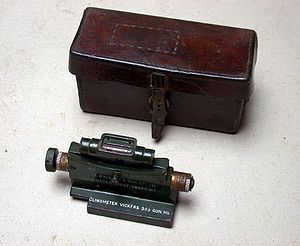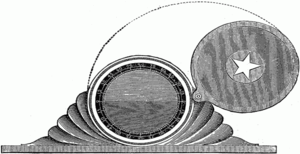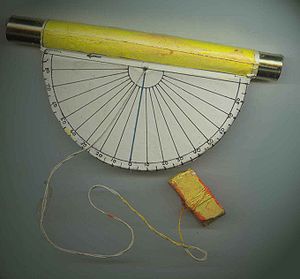Difference between revisions of "AY Honors/Forestry/Answer Key"
| (12 intermediate revisions by the same user not shown) | |||
| Line 1: | Line 1: | ||
| − | [[Image: | + | [[Image:Stanley_compass_1.jpg|thumb|right|200px|Compass with inclinometer]] |
| + | An '''inclinometer''' or '''clinometer''' is an instrument for measuring angles of [[slope]] (or [[tilt]]), [[elevation]] or [[inclination]] of an object with respect to gravity. It is also known as a ''tilt meter'', ''tilt indicator'', ''slope alert'', ''slope gauge'', ''gradient meter'', ''gradiometer'', ''level gauge'', ''level meter'', ''declinometer'', and ''pitch & roll indicator''. | ||
| + | Clinometers measure both inclines (positive slopes, as seen by an observer looking upwards) and declines (negative slopes, as seen by an observer looking downward). | ||
| − | + | In aircraft, the "ball" in [[turn coordinator]]s or [[turn and bank indicator]]s is sometimes referred to as an inclinometer. | |
| − | |||
| − | |||
| − | |||
| − | |||
| − | |||
| − | |||
| − | == | + | ==History== |
| − | + | Early [[inclinometer]]s include examples such as [[Well's inclinometer]], the essential parts of which are a flat side, or base, on which it stands, and a hollow disk just half filled with some heavy liquid. The glass face of the disk is surrounded by a graduated scale that marks the angle at which the surface of the liquid stands, with reference to the flat base. The line 0.—0. being parallel to the base, when the liquid stands on that line, the flat side is horizontal; the line 90.—90. being perpendicular to the base, when the liquid stands on that line, the flat side is perpendicular or plumb. Intervening angles are marked, and, with the aid of simple [[conversion tables]], the instrument indicates the rate of fall per set distance of horizontal measurement, and set distance of the sloping line. | |
| − | |||
| − | + | ==Accuracy== | |
| − | + | [[File:Vickers Clino R.JPG|thumb|Clinometer designed to enable [[indirect fire]] capability with a [[Vickers machine gun]] circa 1918]] | |
| − | + | Certain highly sensitive electronic inclinometer sensors can achieve an output resolution to 0.001 degrees - depending on the technology and angle range, it may be limited to 0.01º. An inclinometer sensor's true or absolute accuracy (which is the combined total error), however, is a combination of initial sets of sensor zero offset and sensitivity, sensor linearity, hysteresis, repeatability, and the temperature drifts of zero and sensitivity - electronic inclinometers accuracy can typically range from .01º to ±2º depending on the sensor and situation. Typically in room ambient conditions the accuracy is limited to the sensor linearity specification. | |
| − | [[Category: | + | [[Image:Well's Clinometer - Project Gutenberg eText 19465.png|thumb|The Well's clinometer]] |
| + | [[Image:Clinometerlow.jpg|thumb|A simple clinometer]] | ||
| + | |||
| + | ==Sensor technology== | ||
| + | |||
| + | [[Tilt sensor]]s and inclinometers generate an [[artificial horizon]] and measure angular tilt with respect to this horizon. They are used in cameras, aircraft flight controls, automobile security systems, and speciality switches and are also used for platform leveling, boom angle indication, indeed anywhere tilt requires measuring. | ||
| + | |||
| + | Important specifications to consider when searching for tilt sensors and inclinometers are the tilt angle range and number of axes (which are usually, but not always, [[orthogonal]]). The tilt angle range is the range of desired linear output. <!-- doesn't matter what it's measured in, and last sentence just repeats the back end of the first --> | ||
| + | |||
| + | Common sensor technologies for tilt sensors and inclinometers are accelerometer, [[Liquid Capacitive Basics |Liquid Capacitive]], electrolytic, gas bubble in liquid, and pendulum. | ||
| + | |||
| + | Tilt sensor technology has also been implemented in video games. ''[[Yoshi's Universal Gravitation]]'' and ''[[Kirby Tilt 'n' Tumble]]'' are both built around a tilt sensor mechanism, which is built into the cartridge. The [[PlayStation 3]] and [[Wii]] game controllers also use tilt as a means to play video games. | ||
| + | |||
| + | Inclinometers are also used in [[civil engineering]], for example to measure the inclination of land to be built upon. | ||
| + | |||
| + | ==Uses== | ||
| + | |||
| + | Inclinometers are used for: | ||
| + | * Determining latitude using [[Polaris]] (in the Northern Hemisphere) or the two stars of the constellation [[Crux]] (in the Southern Hemisphere). | ||
| + | * Determining the angle of the earth's magnetic field with respect to the horizontal plane. | ||
| + | * Showing a deviation from the true vertical or horizontal. | ||
| + | * [[Surveying]], to measure an angle of inclination or elevation. | ||
| + | * Alerting an equipment operator that it may tip over.[http://www.riekerinc.com/TiltIndicators.htm] | ||
| + | * Measuring angles of elevation, slope, or incline, e.g. of an embankment. | ||
| + | * Measuring slight differences in slopes, particularly for [[geophysics]]. Such inclinometers are, for instance, used for monitoring [[volcano]]es, or for measuring the depth and rate of landslide movement. | ||
| + | * Measuring movements in walls or the ground in civil engineering projects.[http://www.slopeindicator.com/instruments/inclin-intro.html] | ||
| + | * Determining the dip of beds or strata, or the slope of an embankment or cutting; a kind of plumb level. | ||
| + | * Some automotive [[safety]] systems. | ||
| + | * Indicating pitch and roll of vehicles, nautical craft, and aircraft. See [[turn coordinator]] and [[slip indicator]].[http://www.riekerinc.com/SlipIndicators.htm] | ||
| + | * Monitoring the boom angle of cranes and material handlers. | ||
| + | * Measuring the "look angle" of a satellite antenna towards a satellite. | ||
| + | * Measuring the slope angle of a tape or chain during distance measurement. | ||
| + | * Measuring the height of a building, tree, or other feature using a vertical angle and a distance (determined by taping or pacing), using [[trigonometry]]. | ||
| + | * Measuring the angle of drilling in [[well logging]]. | ||
| + | * Measuring the [[List (watercraft)|list]] of a [[ship]] in still water and the roll in rough water. | ||
| + | * Measuring steepness of a [[ski slope]]. | ||
| + | * Measuring the orientation of [[plane (mathematics)|plane]]s and [[lineation]]s in rocks, in combination with a [[compass]], in [[structural geology]]. | ||
| + | * Measuring [[Range of Motion]] in the joints of the body | ||
| + | * Measuring the angles of elevation to, and ultimately computing the altitudes of, many things otherwise inaccessible for direct measurement. <!-- POV: This is especially useful in a classroom setting with children who will learn a valuable skill that applies directly to many careers. --> | ||
| + | |||
| + | == See also == | ||
| + | * [[Theodolite]] | ||
| + | * [[Clinometer (forestry)]] | ||
| + | |||
| + | == External links == | ||
| + | *[http://www.inclinometer.blogspot.com Inclinometer Blog - General Inclinometer Information] | ||
| + | |||
| + | [[Category:Surveying instruments]] | ||
[[Category:Dimensional instruments]] | [[Category:Dimensional instruments]] | ||
| + | [[Category:Inclinometers]] | ||
| + | |||
| + | [[ar:مميال]] | ||
| + | [[de:Neigungsmesser]] | ||
| + | [[es:Clinómetro]] | ||
| + | [[fr:Inclinomètre]] | ||
| + | [[it:Clinometro]] | ||
| + | [[ja:クリノメーター]] | ||
| + | [[no:Klinometer]] | ||
| + | [[pl:Inklinometr]] | ||
| + | [[pt:Inclinômetro]] | ||
| + | [[ru:Инклинометр]] | ||
| + | [[sl:Klinometer]] | ||
| + | [[sv:Inklinometer]] | ||
Revision as of 16:48, 27 January 2010
An inclinometer or clinometer is an instrument for measuring angles of slope (or tilt), elevation or inclination of an object with respect to gravity. It is also known as a tilt meter, tilt indicator, slope alert, slope gauge, gradient meter, gradiometer, level gauge, level meter, declinometer, and pitch & roll indicator. Clinometers measure both inclines (positive slopes, as seen by an observer looking upwards) and declines (negative slopes, as seen by an observer looking downward).
In aircraft, the "ball" in turn coordinators or turn and bank indicators is sometimes referred to as an inclinometer.
History
Early inclinometers include examples such as Well's inclinometer, the essential parts of which are a flat side, or base, on which it stands, and a hollow disk just half filled with some heavy liquid. The glass face of the disk is surrounded by a graduated scale that marks the angle at which the surface of the liquid stands, with reference to the flat base. The line 0.—0. being parallel to the base, when the liquid stands on that line, the flat side is horizontal; the line 90.—90. being perpendicular to the base, when the liquid stands on that line, the flat side is perpendicular or plumb. Intervening angles are marked, and, with the aid of simple conversion tables, the instrument indicates the rate of fall per set distance of horizontal measurement, and set distance of the sloping line.
Accuracy
Certain highly sensitive electronic inclinometer sensors can achieve an output resolution to 0.001 degrees - depending on the technology and angle range, it may be limited to 0.01º. An inclinometer sensor's true or absolute accuracy (which is the combined total error), however, is a combination of initial sets of sensor zero offset and sensitivity, sensor linearity, hysteresis, repeatability, and the temperature drifts of zero and sensitivity - electronic inclinometers accuracy can typically range from .01º to ±2º depending on the sensor and situation. Typically in room ambient conditions the accuracy is limited to the sensor linearity specification.
Sensor technology
Tilt sensors and inclinometers generate an artificial horizon and measure angular tilt with respect to this horizon. They are used in cameras, aircraft flight controls, automobile security systems, and speciality switches and are also used for platform leveling, boom angle indication, indeed anywhere tilt requires measuring.
Important specifications to consider when searching for tilt sensors and inclinometers are the tilt angle range and number of axes (which are usually, but not always, orthogonal). The tilt angle range is the range of desired linear output.
Common sensor technologies for tilt sensors and inclinometers are accelerometer, Liquid Capacitive, electrolytic, gas bubble in liquid, and pendulum.
Tilt sensor technology has also been implemented in video games. Yoshi's Universal Gravitation and Kirby Tilt 'n' Tumble are both built around a tilt sensor mechanism, which is built into the cartridge. The PlayStation 3 and Wii game controllers also use tilt as a means to play video games.
Inclinometers are also used in civil engineering, for example to measure the inclination of land to be built upon.
Uses
Inclinometers are used for:
- Determining latitude using Polaris (in the Northern Hemisphere) or the two stars of the constellation Crux (in the Southern Hemisphere).
- Determining the angle of the earth's magnetic field with respect to the horizontal plane.
- Showing a deviation from the true vertical or horizontal.
- Surveying, to measure an angle of inclination or elevation.
- Alerting an equipment operator that it may tip over.[1]
- Measuring angles of elevation, slope, or incline, e.g. of an embankment.
- Measuring slight differences in slopes, particularly for geophysics. Such inclinometers are, for instance, used for monitoring volcanoes, or for measuring the depth and rate of landslide movement.
- Measuring movements in walls or the ground in civil engineering projects.[2]
- Determining the dip of beds or strata, or the slope of an embankment or cutting; a kind of plumb level.
- Some automotive safety systems.
- Indicating pitch and roll of vehicles, nautical craft, and aircraft. See turn coordinator and slip indicator.[3]
- Monitoring the boom angle of cranes and material handlers.
- Measuring the "look angle" of a satellite antenna towards a satellite.
- Measuring the slope angle of a tape or chain during distance measurement.
- Measuring the height of a building, tree, or other feature using a vertical angle and a distance (determined by taping or pacing), using trigonometry.
- Measuring the angle of drilling in well logging.
- Measuring the list of a ship in still water and the roll in rough water.
- Measuring steepness of a ski slope.
- Measuring the orientation of planes and lineations in rocks, in combination with a compass, in structural geology.
- Measuring Range of Motion in the joints of the body
- Measuring the angles of elevation to, and ultimately computing the altitudes of, many things otherwise inaccessible for direct measurement.
See also
External links
ar:مميال de:Neigungsmesser es:Clinómetro fr:Inclinomètre it:Clinometro ja:クリノメーター no:Klinometer pl:Inklinometr pt:Inclinômetro ru:Инклинометр sl:Klinometer sv:Inklinometer




